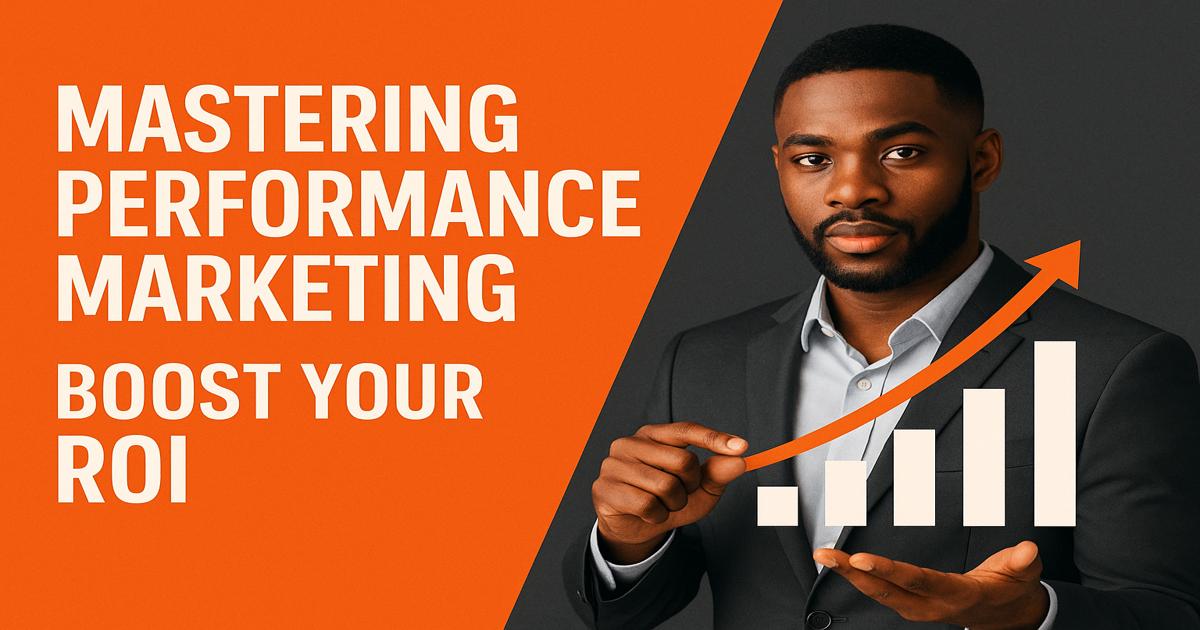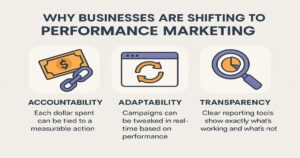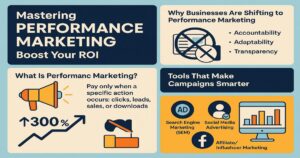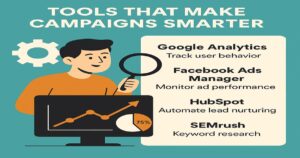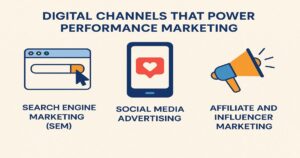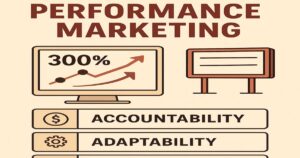What Is Performance Marketing?
Performance marketing is a results-focused form of digital advertising where you pay only when a specific action occurs—clicks, leads, sales, or downloads. Unlike traditional methods that rely on vague metrics like impressions or awareness, this approach ensures your budget is invested in campaigns that drive direct value.
Businesses that implement performance marketing strategies often report a return on investment (ROI) upwards of 300%, making it one of the most efficient paths to scalable growth. For companies navigating an increasingly complex digital space, mastering performance marketing isn’t optional—it’s essential.
Why Businesses Are Shifting to Performance Marketing
Traditional marketing methods like print ads and billboards can be expensive and difficult to measure. In contrast, performance marketing offers detailed tracking, enabling you to see exactly where your budget is going and what’s delivering results.
Benefits That Drive the Shift
- Accountability: Each dollar spent can be tied to a measurable action.
- Adaptability: Campaigns can be tweaked in real-time based on performance.
- Transparency: Clear reporting tools show exactly what’s working and what’s not.
Companies looking to understand the contrast between digital strategies can learn more in this guide to SEO vs. PPC.
Digital Channels That Power Performance Marketing
A key element of success is choosing the right channels. Each platform has strengths, and effective performance marketing blends them.
Search Engine Marketing (SEM)
When users search for solutions, SEM ensures your brand is visible. PPC ads through Google Ads let you bid on high-intent keywords.
- Pros: Targets users ready to act.
- Tip: Use negative keywords to filter out irrelevant clicks.
For localized strategies, explore how to boost visibility with SEM.
Social Media Advertising
Platforms like Facebook, Instagram, and TikTok let you target audiences by interest, location, and behavior. Great for brand discovery and retargeting.
- Strategy: Run carousel ads to showcase multiple products.
- Advantage: Visual formats drive engagement.
Affiliate and Influencer Marketing
Pay others to promote your product. Affiliates or influencers earn a commission on sales they generate.
- Use case: Perfect for e-commerce and SaaS products.
- Tools: PartnerStack and Impact make management easier.
Dive deeper with our guide to content marketing strategies.
Tools That Make Campaigns Smarter
Success in performance marketing requires data and optimization. Here are some tools that help you manage it all:
| Tool | Purpose |
|---|---|
| Google Analytics | Track user behavior and conversions |
| Facebook Ads Manager | Monitor ad performance |
| HubSpot | Automate lead nurturing |
| SEMrush | Keyword and competitive research |
Bonus Tip
Leverage UTM codes to track campaign performance more precisely. This ensures you understand which sources deliver the best ROI.
Mastering Conversion Rate Optimization (CRO)
Getting traffic is only half the equation—turning that traffic into paying customers is where CRO comes in.
Tactics to Improve Conversion
- Heatmaps: Tools like Hotjar show where users click and scroll.
- Landing Pages: Create campaign-specific pages with singular CTAs.
- Trust Signals: Display reviews, badges, or guarantees.
Learn additional tips in this article on digital visibility strategies.
Setting KPIs That Actually Drive Performance
Common KPIs
- CPA (Cost per Acquisition)
- CTR (Click-Through Rate)
- ROAS (Return on Ad Spend)
- LTV (Customer Lifetime Value)
Aligning your KPIs with business objectives ensures you aren’t just generating numbers—you’re generating impact.
Aligning Goals with Business Objectives
If your business aims to increase subscription signups, your campaign should focus on reducing CPA while increasing conversion rate. Tools like Salesforce and HubSpot can integrate marketing goals with CRM data for a unified strategy.
Budget planning? Don’t miss this guide on setting marketing budgets.
Audience Research: Know Who You’re Talking To
Performance marketing thrives on precision. That means deeply understanding your audience.
Steps to Identify Your Audience
- Analyze customer data using Google Analytics.
- Create buyer personas.
- Use Facebook Audience Insights or similar tools.
Competitive Analysis
Benchmark against competitors by analyzing their ad creatives, keywords, and offers using tools like SpyFu or SimilarWeb.
This approach ensures you don’t just keep up—you leap ahead.
Multi-Channel Strategy: More Than Just Ads
Marketing works best when it meets people where they are. Here’s how to integrate channels:
Combine These for Impact:
- Email Marketing: Drip campaigns for nurturing leads.
- Content Marketing: Drive traffic through blogs and guides.
- Social Media: Build community and retarget traffic.
This approach is at the heart of our philosophy at Nesace Media.
Campaign Implementation: Tips for Success
Choosing the Right Ad Platform
Match your product with the platform your audience uses. For example:
- Google Ads: Great for high-intent searches.
- TikTok/Instagram: Ideal for visual storytelling.
- LinkedIn: Best for B2B lead generation.
Writing Effective Ad Copy
Focus on benefits, not features. Use strong verbs, include numbers, and always end with a compelling CTA.
Example: “Save 30% Today – Offer Ends Friday!”
Explore creative campaign examples to inspire your next move.
A/B Testing and Iteration
No campaign is perfect from the start. Use A/B testing to fine-tune:
- Headlines
- Images vs. videos
- CTA button colors
Tools like Google Optimize and VWO make this process simple.
Analyzing Your Performance Data
Measuring success isn’t just about looking at dashboards—it’s about drawing conclusions and making smart decisions.
Metrics That Matter
| Metric | What It Tells You |
|---|---|
| CTR | How compelling your ad is |
| Bounce Rate | User experience issues |
| Conversion Rate | Campaign effectiveness |
| ROAS | Overall profitability |
Use these to iterate, improve, and scale.
Marketing Trends to Watch
Stay ahead of the game by keeping an eye on evolving trends:
- AI & Automation: Tools that auto-optimize bids and placements.
- Voice Search: Tailoring content for “Hey Siri” queries.
- Short-Form Video: Dominant on TikTok, Reels, and YouTube Shorts.
Explore how AI is changing digital marketing.
Key Takeaways
Performance marketing offers a dynamic, data-driven approach to online advertising. By aligning strategy with measurable outcomes, businesses can scale confidently and profitably.
- Use multi-channel strategies for broader reach.
- Monitor and adjust campaigns using real-time data.
- Always optimize—through testing, iteration, and audience insights.
Frequently Asked Questions (FAQs)
How is performance marketing different from traditional marketing?
You pay for actual results—not just exposure.
What’s the best platform for B2B performance marketing?
LinkedIn Ads offer detailed targeting for professional audiences.
How can I reduce my CPA?
Refine your targeting, improve landing pages, and use A/B testing.
Do I need to hire an agency?
If you’re scaling fast, an agency like Nesace Media offers strategic insights and technical execution.
How often should I check performance?
Weekly at a minimum. Use daily check-ins during major campaigns.
Conclusion: Performance Marketing Is the Future
It’s no longer about guessing what works. With performance marketing, every decision is informed, every dollar is accountable, and every result is measurable.
Whether you’re a startup testing your first campaign or an enterprise seeking efficiency at scale, this strategy offers unmatched ROI when executed well.
Ready to make your marketing work harder and smarter? Contact Nesace Media today and let’s grow together.

